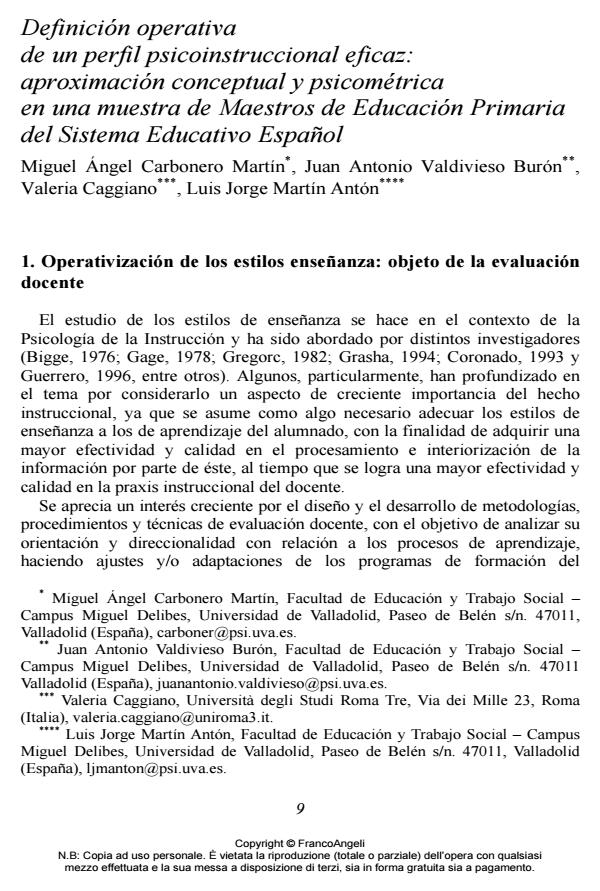Definición operativa de un perfil psicoinstruccional eficaz: aproximación conceptual y psicométrica en una muestra de Maestros de Educación Primaria del Sistema Educativo Espanol
Titolo Rivista CADMO
Autori/Curatori Angel Miguel Carbonero Martìn, Burón Juan Antonio Valdivieso, Valeria Caggiano, Antón Luis Jorge Martín
Anno di pubblicazione 2013 Fascicolo 2013/1 Lingua Spagnolo
Numero pagine 14 P. 9-22 Dimensione file 449 KB
DOI 10.3280/CAD2013-001002
Il DOI è il codice a barre della proprietà intellettuale: per saperne di più
clicca qui
Qui sotto puoi vedere in anteprima la prima pagina di questo articolo.
Se questo articolo ti interessa, lo puoi acquistare (e scaricare in formato pdf) seguendo le facili indicazioni per acquistare il download credit. Acquista Download Credits per scaricare questo Articolo in formato PDF

FrancoAngeli è membro della Publishers International Linking Association, Inc (PILA)associazione indipendente e non profit per facilitare (attraverso i servizi tecnologici implementati da CrossRef.org) l’accesso degli studiosi ai contenuti digitali nelle pubblicazioni professionali e scientifiche
From the construction and validation of a rating scale of self-perceived Competence of the Primary School Teachers (ECAD-EP) is obtained the teacher profile assumed and developed by teachers of primary education belonging to the Spanish educational system that tries to answer operationalization of teaching styles that allow the teacher to discover those features that best demonstrate a high effectiveness. The structure of the scale validity presents a threedimensional factor in the following order: (a) Socio-emotional, composed of the variables: "Coexistence", "Mediation", "Revitalization group", "Emotional involvement", "Adapting communicative", "Communicative sensitivity", "Empathy" and "Self-efficacy"; (b) Communicative- relational, consisting of the variables: "Assertiveness", "Affective leadership", "Executive leadership", "Conflict resolution", "Nonverbal communication" and "Paraverbal communication"; © Instructional, which contains the variables: "Adapting to new situations", "Instructional control" and "Planning". Thus, the theoretical model of teaching as defined initially, has been appreciating elements and factors that form a multidimensional concept of meaning, including not only factual or behavioral variables, but also cognitive and metacognitive, social and emotional. Therefore, teaching is not only seen as a process of sequential linear or uniform but circular in nature with a constant interplay between a number of variables or dimensions and multiple hierarchies.
Keywords:Teaching styles, evaluation of teaching, self-perceived teaching competence, instructional variables, teacher rating scale.
- Bigge, M.L. (1976), Learning Theories for Teachers, New York, NY: Harper&Row; 3ª edición.
- Blanco, A. (2009), Aprender a enseñar, Barcelona: Paidós ibérica.
- Cohen-Vogel, L., Smith, T.M. (2007), “Qualifications and Assignments of Alternatively Certified Teachers: Testing Core Assumptions”, American Educational Research Journal, 44 (3), pp. 732-753.
- Coronado, H. (1993), Caracterización de los Estilos Pedagógicos predominantes en la enseñanza de las Ciencias Biológicas en el Noveno Grado de educación básica. Trabajo de Grado de Maestría, Universidad Pedagógica Experimental Libertador (Venezuela).
- Corradi, F. (2012), “Est-il possible de définir un profil plus éfficace? Comparaison entre enseignants français et italiens”, Cadmo, XX (1), pp. 65-94.
- Elizalde, L., Reyes, R. (2008), “Elementos clave para la evaluación del desempeño de los docentes”, Revista Electrónica de Investigación Educativa, número especial, http://redie.uabc.mx/NumEsp1/contenido-elizaldereyes.html (el 24 de junio de 2010).
- Felder, R.M., Henriques, E.R. (1995), “Learning and Teaching Styles in Foreign and Second Language Education”, en D.A. Grouws (ed.), Handbook of Research on Mathematics Teaching and Learning, New York: Macmillan Publishing Company, pp. 147-164.
- Gage, N. (1978), Aprendizaje Escolar y Evaluación, Buenos Aires: Editorial Paidós.
- Grasha, A. (1994), “A Matter of Style: The Teacher as Expert, Formal Authority, Personal Model, Facilitator and Delegator”, College Teaching, 42 (4), pp. 142-149.
- Gregorc, A. (1982), Style Delineator, Maynard, MA: Gabriel Systems.
- Guerrero, N.M. (1996), Evaluación de los Estilos de Enseñanza y los Estilos de Aprendizaje como vía para mejorar la calidad de la instrucción en el Colegio Universitario de Los Teques Cecilio Acosta, Universidad Pedagógica Experimental Libertador, Instituto Pedagógico de Miranda “José Manuel Siso Martínez”. Centro de Documentación e Información Educativa (CENDIE).
- Imbernon, F. (1994), La formación y desarrollo profesional del profesorado. Hacia una nueva cultura profesional, Barcelona: Editorial Graó.
- Liu, R., Qiao, X., Liu, Y. (2004), “A Paradigm Shift of Learner-centered Teaching Style: Reality or Illusion?”, Arizona Working Papers, 13, pp. 77-91.
- Mañú, J.M., Goyarrola, I. (2011), Docentes competentes. Por una educación de calidad. Madrid: Narcea.
- Martínez, F. (1999), El perfil del profesor universitario en los albores del siglo XXI. I Encuentro Iberoamericano de Perfeccionamiento integral del profesor universitario, Caracas: Universidad Central de Venezuela.
- Mohan, L., Lundeberg, M.A., Reffitt, K. (2008), “Studying Teachers and Schools:
- Michael Pressley’s Legacy and Directions for Future Research”, Educational Psychologist, 43 (2), pp. 107-118.
- Pecheone, R.L., Chung, R.R. (2006), “Evidence in Teacher Education. The Performance Assessment for California Teachers (PACT)”, Journal of Teacher Education, 57 (1), pp. 22-36.
- Ridley, D.S., Hurwitz, S., Hackett, M.R.D., Miller, K.K. (2005), “Comparing PDS and Campus-based Preservice Teacher Preparation. Is PDS-based Preparation really better?”, Journal of Teacher Education, 56 (1), pp. 46-56.
- Searfoss, L.W., Enz, B.J. (1996), “Can Teacher Evaluation reflect Holistic Instruction?”, Educational Leadership, 53 (6), pp. 38-41.
- Tam, K.P., Pak, S.T., Hui, C.H., Kwan, S.O., Goh, M.K.H. (2010), “Implicit Person Theories and Chane in Teacher Evaluation: A Longitudinal Field Study”, Journal of Applied Social Psychology, 40 (2), pp. 273-286.
- Van Zandt, L.M. (1998), “Assessing the Effects of Reform in Teacher Education: An Evaluation of the 5-year MAT Program at Trinity University”, Journal of Teacher Education, 49 (2), pp. 120-131.
- Wilmut, J. (2007), “Developing School Teachers’ Expertise in Assessment: Education, Development and Support”, Cadmo, 1, pp. 49-59.
- Yu, S., Ding, R.J. (2009), “Multi-level Fuzzy Assessment Application in Teaching Evaluation”, ICAIE 2009: Proceedings of the 2009 International Conference on Artificial Intelligence and Education, Huazhong: Normal Univ. China Assoc Educ. Technol., vols. 1-2, pp. 94-98.
Angel Miguel Carbonero Martìn, Burón Juan Antonio Valdivieso, Valeria Caggiano, Antón Luis Jorge Martín, Definición operativa de un perfil psicoinstruccional eficaz: aproximación conceptual y psicométrica en una muestra de Maestros de Educación Primaria del Sistema Educativo Espanol in "CADMO" 1/2013, pp 9-22, DOI: 10.3280/CAD2013-001002